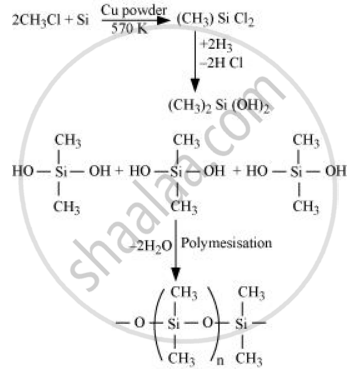Advertisements
Advertisements
प्रश्न
Explain the following reaction.
Silicon is heated with methyl chloride at high temperature in the presence of copper.
उत्तर
When silicon reacts with methyl chloride in the presence of copper (catalyst) and at a temperature of about 537 K, a class of organosilicon polymers called methyl-substituted chlorosilanes (MeSiCl3, Me2SiCl2, Me3SiCl, and Me4Si) are formed

APPEARS IN
संबंधित प्रश्न
Discuss the pattern of variation in the oxidation states of B to Tl.
Discuss the pattern of variation in the oxidation states of C to Pb.
Elements of group 14 ________.
Rationalise the given statement and give a chemical reaction:
Lead (IV) chloride is highly unstable towards heat.
Rationalise the given statement and give a chemical reaction:
Lead is known not to form an iodide, PbI4.
Classify the following oxide as neutral, acidic, basic or amphoteric:
CO
Classify the following oxide as neutral, acidic, basic or amphoteric:
SiO2
Classify the following oxide as neutral, acidic, basic or amphoteric:
Al2O3
Write suitable chemical equations to show the nature of the following oxide.
B2O3
The reason for small radius of Ga compared to Al is:
(i) poor screening effect of d and f orbitals.
(ii) increase in nuclear charge.
(iii) presence of higher orbitals.
(iv) higher atomic number.
Give reasons for the following:
CCl4 is immiscible in water, whereas SiCl4 is easily hydrolysed.
The +1 oxidation state in group 13 and +2 oxidation state in group 14 becomes more and more stable with increasing atomic number. Explain.
Carbon and silicon both belong to the group 14, but inspite of the stoichiometric similarity, the dioxides, (i.e., carbon dioxide and silicon dioxide), differ in their structures. Comment.
Stannous chloride solution when kept in the air turns milky due to the formation of ______.
Which one of the following compounds of Group–14 elements is not known?
